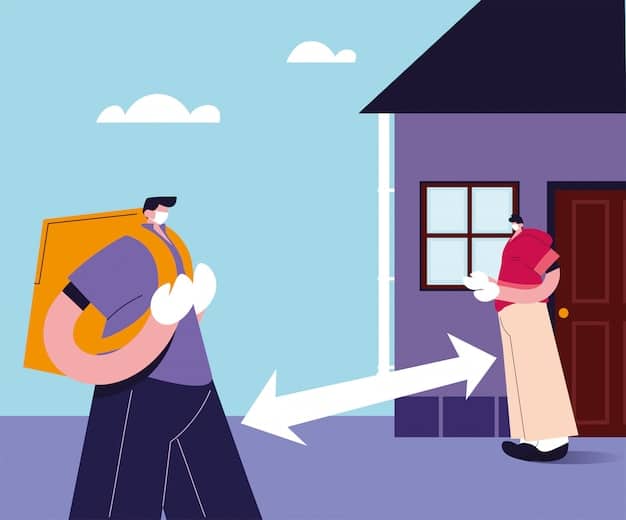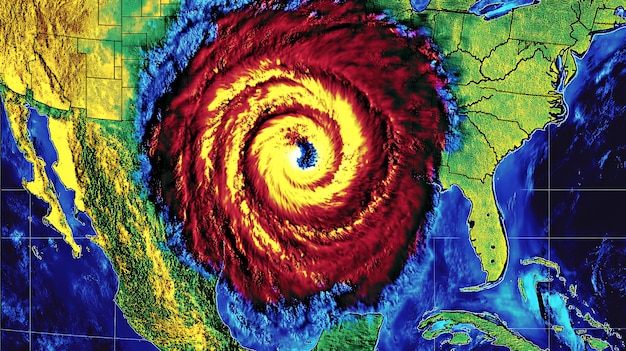2025 Hurricane Season: Updated Forecast and Preparedness Guide for US Residents

The 2025 hurricane season is projected to be highly active, with an above-normal number of named storms and major hurricanes expected to impact the US; preparedness, including creating a disaster plan and stocking up on supplies, is crucial for residents in vulnerable areas.
As we approach 2025 hurricane season, understanding the updated forecasts and implementing preparedness measures is crucial for US residents in vulnerable areas. This guide provides essential information to help you stay safe and informed.
Understanding the 2025 Hurricane Season Forecast
The 2025 hurricane season is anticipated to be particularly active, with forecasters predicting an above-average number of named storms. Understanding these forecasts is the first step in preparing for potential impacts.
Key Forecast Elements
Several key elements contribute to the overall hurricane season forecast. Sea surface temperatures, atmospheric conditions, and historical data are all closely monitored to provide the most accurate predictions possible.
- Sea Surface Temperatures: Warmer waters fuel hurricanes, increasing their intensity and duration. Higher than average temperatures are expected in the Atlantic basin.
- Atmospheric Conditions: Wind shear, air pressure, and humidity levels play a crucial role in storm development. Favorable conditions can lead to rapid intensification.
- Historical Data: Past hurricane seasons provide valuable insights into potential patterns and trends. Analyzing historical data helps forecasters refine their predictions.
Staying informed about these key elements can help you understand the potential severity of the upcoming hurricane season and take appropriate precautions.
In conclusion, understanding the elements that constitute predictions for the hurricane season is crucial for homeowners and coastal residents.
Assessing Your Risk: Where Are You Most Vulnerable?
Not all areas are equally vulnerable to hurricanes. Understanding your geographical risk is essential for tailoring your preparedness efforts. Coastal regions, low-lying areas, and flood zones are particularly susceptible to hurricane impacts.

Coastal Regions
Coastal regions face the most direct impacts from hurricanes, including storm surge, high winds, and heavy rainfall. Residents in these areas should be prepared for potential evacuations.
Storm surge can cause catastrophic flooding, inundating homes and businesses. High winds can damage structures and infrastructure, leading to power outages and widespread destruction. Heavy rainfall can trigger inland flooding, further exacerbating the impacts.
Low-Lying Areas and Flood Zones
Low-lying areas and flood zones are at increased risk of flooding during hurricanes. Even areas located several miles inland can experience significant flooding from heavy rainfall and overflowing rivers.
- Identify whether you live in a potential flood zone
- Know your evacuation routes and high ground locations
- Purchase flood insurance and know the details
Ultimately, assessing your personal geographical risk is crucial in determining the proper measures you should take for yourself and your loved ones. Whether your property is coastal, or inland near low lying areas, preparedness can be life saving.
Creating a Comprehensive Disaster Plan
A well-developed disaster plan is your roadmap for staying safe during a hurricane. This plan should include evacuation strategies, communication protocols, and emergency contacts.
Evacuation Strategies
If you live in an evacuation zone, know your designated evacuation routes and have a plan for where you will go. Consider staying with friends or family outside the affected area or booking a hotel in advance.
Remember to account for potential traffic delays and road closures. Have multiple evacuation routes in mind in case your primary route is blocked. Ensure your vehicle is in good working condition and has a full tank of gas.
Communication Protocols
Stay connected with family members and emergency services during a hurricane. Designate a central contact person who lives outside the affected area and can relay information. Keep your cell phone charged and have a backup power source.
Sign up for local emergency alerts and monitor weather updates from reputable sources. Social media can also be a valuable tool for staying informed, but be sure to verify information before sharing it.
Having a comprehensive disaster plan will help ensure the safety of everyone in your family.
Stocking Up on Essential Supplies
Having a well-stocked emergency kit is crucial for weathering a hurricane. Essential supplies include food, water, medication, and first-aid items.

Food and Water
Stock up on non-perishable food items, such as canned goods, granola bars, and dried fruit. Aim for at least a three-day supply per person. Store enough bottled water too.
Medication and First-Aid
Ensure you have an ample supply of any prescription medications you take, as well as over-the-counter pain relievers and cold remedies. A well-stocked first-aid kit should include bandages, antiseptic wipes, and any other supplies you may need to treat minor injuries.
- Non-perishable Food
- Bottled Water
- First-Aid Kit
- Medications
Having essential supplies is paramount to surviving the storm at its worst. If you prepare accordingly, the storm won’t take you by surprise without food, water, or medical supplies.
Protecting Your Property from Hurricane Damage
Taking proactive measures to protect your property can minimize damage from hurricanes. Reinforcing your home, securing outdoor items, and trimming trees will help mitigate potential risks.
Reinforcing Your Home
Consider reinforcing your home’s structure to withstand high winds. Install hurricane shutters or board up windows with plywood. Secure your roof with hurricane straps and ensure your garage door is properly reinforced.
These measures can prevent windows from shattering. Bolted roofs are much more resistant to strong weather systems and high speed winds. These are preventative measures worth taking, especially since this hurricane season is supposed to be especially intense.
Securing Outdoor Items
Bring in or securely anchor any outdoor furniture, planters, and other loose objects. These items can become dangerous projectiles in high winds, causing damage to your property and nearby structures.
Trim trees and shrubs around your home to prevent branches from falling and causing damage. Remove any dead or diseased trees that could pose a hazard. Clear your gutters and downspouts to ensure proper drainage and prevent water damage.
In conclusion, there are many things you can do to weather any hurricane season. You can secure external objects, trim shrubbery, bolt your roof and board your windows.
Staying Informed and Connected During the Storm
During a hurricane, staying informed and connected is crucial for receiving timely updates and staying safe. Monitor weather broadcasts, heed official warnings, and maintain communication with family and friends.
Staying Abreast of Storm Updates
Monitor weather broadcasts from the National Weather Service and local news outlets. Stay tuned to radio, television, or online sources for the latest information on the storm’s track, intensity, and potential impacts. Heed any evacuation orders or safety advisories issued by local authorities.
Be certain to only get your information from a trusted online News outlet. Rumors and other falsehoods spread easily online, so being smart about your media sources is important to staying safe.
Maintaining Communication
Keep your cell phone charged and have a backup power source in case of power outages. Maintain communication with family and friends to check on their well-being and coordinate assistance if needed. Use text messaging or social media to conserve battery power and avoid overloading phone networks.
Designate a central contact person who lives outside the affected area and can relay information to family members. This can be especially helpful if communication lines are disrupted in the affected area.
Staying informed and connected is vital for receiving timely in the moment updates, such as the storm’s new predicted direction, so that you can maximize your available time to make the most educated decision for yourself and your family.
| Key Aspect | Brief Description |
|---|---|
| 🌊 Forecast | High activity expected; stay updated on storm tracks. |
| 🏠 Risk Assessment | Coastal and low-lying areas face greatest threat. |
| 🎒 Supplies | Stock up on food, water, and first-aid essentials. |
| 📱 Communication | Keep devices charged; have a backup plan. |
Frequently Asked Questions (FAQ)
▼
The 2025 hurricane season is expected to be highly active, with an above-average number of named storms and major hurricanes predicted. Warmer sea surface temperatures are a factor.
▼
Check local flood maps and evacuation zone information provided by your city or county. Coastal and low-lying areas are generally at higher risk, as are areas near major rivers.
▼
Include a three-day supply of non-perishable food and water, a first-aid kit, medications, a flashlight, a radio, extra batteries, and personal hygiene items. Don’t forget pet supplies if needed.
▼
Install hurricane shutters or board up windows, reinforce your roof and garage door, and secure outdoor items. Trim trees and clear gutters to prevent debris from causing damage during high winds.
▼
Monitor weather broadcasts from the National Weather Service and local news outlets. Follow official social media accounts for updates from emergency management agencies. Be wary of unverified information shared online.
Conclusion
Preparing for the 2025 hurricane season involves staying informed, assessing your risk, creating a comprehensive plan, and taking proactive measures to protect your home and family. By following these guidelines, you can minimize the potential impacts and ensure your safety during this active season.





